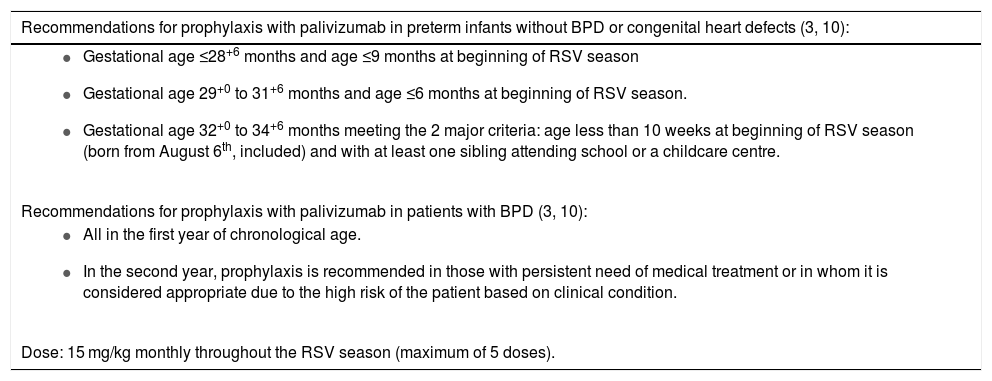Bronchiolitis, and in particular bronchiolitis caused by respiratory syncytial virus (RSV), is the leading cause of hospital admission in infants aged less than 1 year in Spain. Healthy infants born to term are the infants that require admission due to RSV bronchiolitis most frequently, however, infants in the at-risk group, that is, those born preterm, with bronchopulmonary dysplasia (BPD), with haemodynamically significant congenital heart defects, Down syndrome, neuromuscular disorders or velocardiofacial syndrome are at higher risk of developing severe disease.1
General preventive measures such as breastfeeding, hand hygiene and avoiding exposure to tobacco smoke or crowding are essential. However, in the group of patients at highest risk of severe RSV infection, palivizumab continues to be the only drug authorised for pharmacological prophylaxis.
In 2014, the American Academy of Pediatrics (AAP) published new guidelines with particular emphasis on economic aspects calling for a significant restriction in the use of palivizumab prophylaxis, which have remained without changes in a recent publication.2
Recently, the Standards Committee of the Sociedad Española de Neonatología (Spanish Society of Neonatology, SENeo) concluded that the new guideline of the AAP did not contribute additional scientific evidence calling for any changes in the current recommendations for Spain. However, and with the aim of reducing the economic impact of palivizumab prophylaxis due to its high cost, the Committee proposed modifications to ensure its correct and rational use.3
There has been evidence of an increase in the incidence of severe disease due to RSV infection in inpatient populations, especially in infants born preterm, who in the past used to receive prophylaxis but stopped receiving it following the changes in the recommendations of the AAP in 2014, accompanied by a considerable increase in the costs associated with hospitalization.4
In this sense, the most drastic cut recommended by the AAP concerned the population of infants born preterm at or after 29 weeks’ gestation. There is no question that this is a fairly large population, but it is one in which the proportion of RSV infections that produce severe disease requiring hospital admission is very high. For this reason, the Standards Committee of the SENeo3 determined that there is a higher-risk group within this population that, if identified accurately, comprises patients that could benefit greatly from prophylaxis in both the short and the long term, as corroborated by recent evidence.5
The AAP, based on data from descriptive study,6 determined that the use of risk factors as predictors in the population aged less than 5 years does not allow a clear definition of the subsets that would most benefit from prophylaxis, and therefore concluded that it is not justified for the purpose of identifying at-risk populations.
However, the use of risk factors based on data from well-designed studies in populations at high risk of hospitalization due to bronchiolitis has demonstrated that this approach can correctly identify the groups that could most benefit from prophylaxis, especially in the case of studies that include data from the population of the country of interest.7
Recent evidence has demonstrated that in this high-risk group, the use of palivizumab prophylaxis is cost-effective taking into consideration nationwide data and using a societal perspective for the first time.8
Patients with BPD constitute a group at high risk of developing RSV-associated severe illness requiring hospitalization, even after 12 months of age. It has been established that at ages 18–24 months, the risk of requiring hospitalization due to severe RSV infection in these patients is as high as the risk in infants born to term in the first 2 months of life (10%–12%).9 This clearly demonstrates the importance of maintaining prophylaxis in this population.
A consensus document has been recently published proposing recommendations based on a systematic review of the literature and the best clinical evidence published between 2013 and 2018.10
This document defines age groups and high-risk groups that may benefit more from prophylaxis, such as infants born preterm between 29 and 31 weeks’ gestation and infants born preterm after 32 weeks’ gestation based on their risk factors, and maintains the recommendation of prophylaxis in children with Down syndrome, immunosuppression, haemodynamically significant congenital heart defects, neuromuscular disorders or cystic fibrosis.10
Based on the best current scientific evidence,10 the Standards Committee of the SENeo maintains the recommendations issued in 2015,3 reinforcing the role of risk factors in the identification of subsets of infants born preterm between 32 and 35 weeks’ gestation and the application of individualised clinical criteria in patients with BPD during the second year of life (Table 1).
Recommendations for prophylaxis.
| Recommendations for prophylaxis with palivizumab in preterm infants without BPD or congenital heart defects (3, 10): |
|---|
|
| Recommendations for prophylaxis with palivizumab in patients with BPD (3, 10): |
|
| Dose: 15 mg/kg monthly throughout the RSV season (maximum of 5 doses). |
MSL has participated in conferences and working groups funded in part by AbbVie and Sanofi. SRG has participated in conferences and working groups funded by AbbVie.
Please cite this article as: Sánchez Luna M, et al. Recomendaciones de la Sociedad Espa˜nola de Neonatología para la utilización de palivizumab como profilaxis de las infecciones graves por el virus respiratorio sincitial en lactantes de alto riesgo, actualización. An Pediatr (Barc). 2019;91:348–350.





